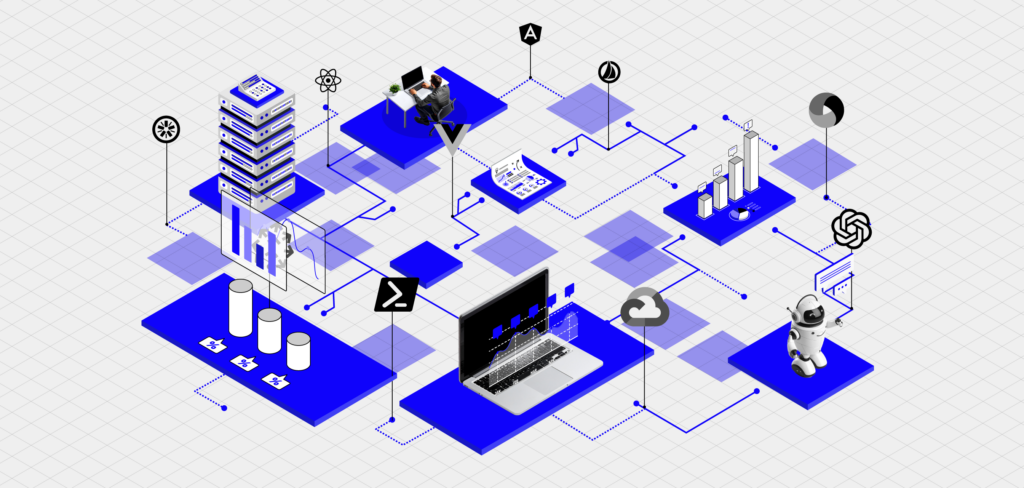New paradigms are emerging at a dizzying pace, which is why, as a developer deeply immersed in this evolution, our CTO, Alejandro Durán, has observed that keeping pace isn’t enough; understanding the foundational shifts that redefine how we build software is massive. The recent Google Cloud Next 2025 conference didn’t just present progressive updates; it signaled a profound transformation towards an “Agentic era.” This crucial shift, from writing lines of code to orchestrating intelligent AI agents, presents both an exhilarating opportunity and a significant challenge for developers and U.S. companies alike. It’s a journey from simply using AI tools to achieving actual AI adoption, demanding strategic cultural and technical shifts that are vital for productivity, scalability, and competitive advantage in the modern market.
The Fine Line: Use vs. Adoption
In the current AI panorama, a significant distinction has emerged between the casual “use” of AI and its strategic “adoption.” While many professionals globally, including those in nearshore talent pools, are already applying AI tools in their daily tasks – from developers using generative AI for code completion to marketing teams drafting copy – this often represents a tactical, isolated application. A 2025 industry report suggests that while over 80% of tech professionals globally now “use” AI in some capacity, only a fraction of their organizations, perhaps 15%, have truly “adopted” AI as a cohesive, enterprise-wide strategy. This highlights a critical challenge for many U.S. companies: the vast potential of AI remains largely untapped because they haven’t moved beyond superficial engagement. True AI adoption is about integrating AI into the very fabric of the business, transcending individual productivity hacks to drive systemic, strategic, and integrated transformation, a complex endeavor where nearshore talent can provide the specialized expertise and scalable support needed.
Alejandro Duran’s Vision: Architecting True AI Integration
To truly grasp what distinguishes AI “use” from “adoption,” we recently sat down with our CTO, Alejandro Durán, a visionary leader driving his strategic evolution. We asked him, “When considering your AI strategy, how are you approaching the architectural evolution, specifically concerning MLOps pipelines and foundational data governance frameworks, necessary for enterprise-wide AI adoption, as opposed to the isolated, tactical use of individual AI tools by different teams?”
Alejandro emphasized:
“We’re building AI into our architecture from the ground up. This entails formalizing MLOps pipelines for reproducibility, monitoring, and versioning, as well as implementing a centralized data governance framework to ensure data quality, access control, and compliance throughout the organization. This shifts us from isolated tool usage to scalable, enterprise-grade AI integration.”
This commitment to robust infrastructure and governance is precisely what US companies need to sustain meaningful AI initiatives.
Our conversation then moved to the developer’s direct role. I probed further: “Beyond the immediate productivity gains from developers using generative AI for code completion or prompt engineering, what technical strategies are you implementing to drive the deeper adoption of AI in your software development lifecycle, such as automated testing, intelligent code reviews, or AI-driven architectural design?”
Alejandro articulated:
“We’re embedding AI into the SDLC through automated test generation, ML-assisted code reviews, and architectural design simulations using LLMs. We’re also exploring AI copilots tailored to our tech stack, enabling deeper automation beyond surface-level code suggestions. The CRAFT framework is also another important component.”
This proactive strategy ensures that our developers are not just AI users but AI integrators, aligning perfectly with the demand for AI-ready talent in the US market. Our dedication to optimizing developer productivity through AI-powered workflows is at the heart of our strategy at Stateside.

The Multi-Agent Border and Security Imperatives
The discussion then shifted to the bleeding edge of AI – the rise of intelligent agents. We asked Alejandro, “With the increasing prevalence of AI agents, how do you technically differentiate between the mere use of a single AI agent for a specific task (e.g., a chatbot for customer service) versus the strategic adoption of an interoperable multi-agent ecosystem that can autonomously collaborate across various enterprise systems?”
Alejandro’s response clarified the distinction:
“A single agent solves a task; a multi-agent ecosystem coordinates across systems. We architect for interoperability using a shared memory layer, role-based agents with explicit communication protocols, and orchestration logic, enabling dynamic collaboration and system-level intelligence across the enterprise.”
This vision of interconnected agents is where true enterprise automation lies, offering transformative potential for US companies seeking scalable, integrated AI solutions.
However, as AI integrates more deeply into core business processes and decision-making, security becomes paramount. I then questioned, “As AI becomes more deeply adopted into core business processes and decision-making, what advanced security protocols and compliance frameworks are you implementing at the infrastructure and application layers to manage the unique risks associated with AI, which go beyond the standard security considerations for general software use?”
Alejandro detailed:
“We’re extending security beyond the standard perimeter: integrating LLM-specific input/output monitoring, adversarial prompt detection, and encrypted audit logs. On the compliance side, we’re aligning with frameworks such as NIST AI RMF and ISO 42001 to handle bias, explainability, and model lifecycle transparency.”
This proactive stance addresses the complex AI security and governance challenges that US enterprises face, ensuring the ethical and resilient adoption of AI.
Conclusion
Google Cloud Next 2025 sent a clear message: AI is no longer a futuristic concept but a present-day imperative driving unprecedented transformation. The distinction between only “using” AI tools and truly “adopting” AI as a core strategic capability is the new border for U.S. companies. True AI adoption demands foundational architectural shifts, deep integration into the software development lifecycle, and robust security and governance frameworks.
At Stateside, we are at the forefront of this evolution, preparing our talent and solutions to help U.S. companies move beyond simple AI tools towards comprehensive, secure, and high-performing AI adoption. We understand that while AI tools empower individuals, the real AI transformation lies in the systemic integration that reshapes an entire organization. Our aim is not only to facilitate this transition but also to inspire a future where Stateside’s logo stands proudly on the “Partners Slide” at future industry events, showcasing our commitment to driving AI innovation and excellence.
If your U.S. company is ready to move beyond simply using AI and achieve actual, transformative AI adoption, schedule a meeting with Stateside’s experts today to discuss how our globally aligned talent can power your next-generation solutions.



